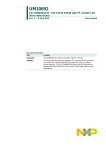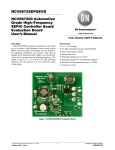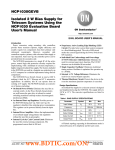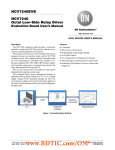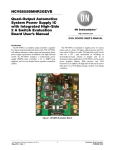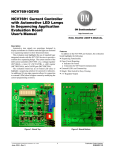Download NCV7718, NCV7720 Half-Bridge Driver
Transcript
NCV7718EVB, NCV7720EVB NCV7718, NCV7720 Half-Bridge Drivers Evaluation Board User's Manual http://onsemi.com EVAL BOARD USER’S MANUAL Description Features The NCV7717-7720 evaluation board provides a convenient method to evaluate the NCV7718 and NCV7720 half-bridge drivers in a suitable application environment. A one board solution for all the drivers in the family is possible since all the devices share the same package and common pin-out structure. The evaluation board is intended to be used with the ON Semiconductor FlexMOS GUI installed on a personal computer (PC) and the USB to SPI interface adapter board for a master-slave communication between the target board and the PC. The evaluation boards allow flexible configuration of the various loads and each of the half-bridges can be individually controlled via the FlexMOS GUI. The evaluation board is populated with an adjustable LDO (NCV4276), so a 3.3 V or 5 V digital supply voltage (VCC) can be selected through the GUI. By means of a jumper the user can bypass the onboard regulator and use an external power supply. Furthermore the onboard LEDs provide visual indication of the board configuration. An external reverse battery circuitry is implemented on the evaluation board to protect the integrated driver in scenarios where the VBAT supply polarity is reversed. This feature can be disabled by slightly modifying the board. • One Hardware Solution for NCV7718 and NCV7720 Half−Bridge Drivers • 0.55 A Peak Current • High Side and Low Side Drivers Connected as Half-Bridge Configuration • Rdson = 1 W (typ) • 3.3 V or 5 V VCC Operation with an Onboard Adjustable Regulator • Over Current and Over Temperature Protection • Under Load Detection • Dedicated GUI Interface for Device Control and Diagnostic Figure 1. FlexMOS Evaluation Board Solution © Semiconductor Components Industries, LLC, 2012 February, 2012 − Rev. 2 1 Publication Order Number: EVBUM2048/D NCV7718EVB, NCV7720EVB Half−Bridge Outputs 24 Pin Interface Connector Supply Requirements Test Points Ground Bus Wire LED Indicators Supply Disconnect Figure 2. Evaluation Board Table 1. ABSOLUTE MAXIMUM RATINGS Rating Value Units Main Supply Voltage (VBAT) Without Reverse Battery Protection Circuitry With Reverse Batter Protection Circuitry −0.3 to 40 −60 to 40 V External Digital Supply Voltage (VCC) −0.3 to 5.5 Output Pins (OUTx) Without Reverse Battery Protection Circuitry With Reverse Batter Protection Circuitry −0.3 to 40 −60 to 40 USB to SPI Interface Adapter Connector Pins −0.5 to 5.5 V Junction Temperature (NCV7718, NCV7720) −40 to 150 °C Ambient Temperature (Evaluation board) −40 to 105 °C V V Stresses exceeding Maximum Ratings may damage the device. Maximum Ratings are stress ratings only. Functional operation above the Recommended Operating Conditions is not implied. Extended exposure to stresses above the Recommended Operating Conditions may affect device reliability. Table 2. RECOMMENDED OPERATING CONDITIONS Rating Units Value Min Max External Digital Supply Voltage (VCC) 3.15 5.25 V Main Supply Voltage (VBAT) 5.5 DC Output Current (Per Channel) Junction Temperature −40 http://onsemi.com 2 28 V 0.55 A 125 °C NCV7718EVB, NCV7720EVB Table 3. PIN FUNCTION DESCRIPTION Connector Pin Number Terminal Name 24 Pin Interface Connector 1 SCL I2C Clock Line, 3.3 V Levels 2 SDA I2C Data Line, 3.3 V Levels 3 GND Ground 4 GND Ground 5 PO7 General-Purpose Output 7 6 PO6 General-Purpose Output 6 7 PO5 General-Purpose Output 5 8 PO4 General-Purpose Output 4, used for controlling the LDO reference 9 PO3 General-Purpose Output 3 10 PO2 General-Purpose Output 2 11 PO1 General-Purpose Output 1, used for EN, Chip Enable 12 PO0 General-Purpose Output 0 13 GND Ground 14 GND Ground 15 PI1 General-Purpose Input 1, used for reading latched thermal shutdown (TSD) data 16 PI0 General-Purpose Input 0 17 VIO 3.3 V or 5 V for level translators 18 PI2 General-Purpose Input 2 19 SO SPI data from slave to master 20 SI SPI data from master to slave 21 SCLK SPI clock from master to slave 22 CSB SPI slave chip select bar 23 VTRGT 24 VCC_USB 5 V USB voltage from the USB to SPI adapter board to the demonstration board (100 mA max) VBAT Main Supply Voltage. Powers the NCV77xx drivers and the onboard LDO. Supply Requirement Half−Bridge Outputs (Note 1) GND_M Description 5 V Supply from slave to J1 Module Ground VCC Optional external digital supply (used only when the onboard LDO is disconnected via VCC_DIS jumper) OUT1 Half Bridge Output 1 OUT2 Half Bridge Output 2 OUT3 Half Bridge Output 3 OUT4 Half Bridge Output 4 OUT5 Half Bridge Output 5 OUT6 Half Bridge Output 6 OUT7 Half Bridge Output 7 OUT8 Half Bridge Output 8 OUT9 Half Bridge Output 9 OUT10 Half Bridge Output 10 http://onsemi.com 3 NCV7718EVB, NCV7720EVB Table 3. PIN FUNCTION DESCRIPTION Connector Test Points Name V5_EN EN Enable signal for the integrated driver. Latched thermal information. (Note 2) CSB Chip Select Bar signal produced by the master. CSB LED is illuminated when CSB transition to a low state. SCLK Serial clock signal generated by the master. SI Serial input data from the master. SO Serial output data from the slave VCC GND Supply Disconnect When this signal is high the LDO is programmed for 5 V output. TSD V_USB LED Indicator Description EN Digital Supply voltage. Supply voltage from the USB port. Chip Ground EN LED is illuminated when the part is enabled. TSD TSD LED is illuminated when part encountered a latched thermal shutdown. (Note 2) CSB CSB LED is illuminated when CSB transition to a low state. VCC VCC LED is illuminated when the LDO is regulating. VCC_REG VCC_REG LED is illuminated when the regulated voltage is applied to the demonstration board. VBAT_DIS VBAT_DIS jumper is used to disconnect the VBAT supply from the board. No power is delivered to the integrated driver or the LDO when the jumper is disconnected. VCC_DIS VCC_DIS jumper is used to disconnect the VCC supply from the LDO to the board. When the jumper is disconnected the board can be powered from an external supply. 1. OUT7 − OUT10 are only available in NCV7720 devices. 2. SI is OR’ed with the TSD fault, so if the LSB bit (B0) is set high on the previous frame the TSD will be set high. http://onsemi.com 4 NCV7718EVB, NCV7720EVB OPERATIONAL GUIDELINES The material necessary to successfully use the demonstration boards is given hereunder: • PC running the latest Onsemi FlexMOS GUI • USB cable Type A to Type B • USB to SPI Interface Adapter with Ribbon Cable • NCV7717-7720 Evaluation Board • Power Supply • Resistive, Inductive or Motor Load An application example of a NCV7720 driving motor loads is given in Figure 3. The same concept can be applied to the rest of the half-bridge integrated drivers in the family and for different load types. Figure 3 shows the VCC_DIS and the VBAT_DIS jumpers inserted, so the digital supply and battery voltage is applied to the board. When VBAT voltage is applied to the board, the onboard regulator regulates the VCC voltage. By default the VCC is regulated to 3.3 V, but this can be adjusted to 5 V via the GUI. The onboard LED VCC_REG is illuminated when the regulator is active. If the VCC power is delivered to the board (VCC_DIS is closed) the VCC LED is also activated. MOTOR 4 MOTOR 2 12V MOTOR 5 MOTOR 3 MOTOR 1 Figure 3. Application Example The FlexMOS GUI is used to enable or disable the device and to control the half−bridge outputs. For the application example given in Figure 3, the motor 1 is driven in the forward direction by enabling the high side power MOSFTET on OUT1 and the low side power MOSFET on OUT5. Conversely the current can be directed to flow in the reverse direction by enabling the low side power MOSFTET on OUT1 and the high side power MOSFET on OUT5. The same methodology can be carried out for the subsequent motor operations by controlling their respective outputs. Once the hardware is configured with the desired load and is interfaced with the USB to SPI adapter, the user can invoke the FlexMOS software. Once the software is launched the GUI should automatically identify the connected demonstration board and loads the appropriate GUI interface for the half-bridge driver. If the software doesn’t recognize the connected demonstration board, manually select the device from the drop down box. If the device name doesn’t appear in the drop down box, the latest version of the GUI needs to be installed on the PC. A detailed description of the GUI functionality for the NCV7718 is provided in Figure 4. http://onsemi.com 5 Half−Bridge Control 6 SPI Traffic Status Info http://onsemi.com Figure 4. GUI Overview Enable Device: Enables or disables the integrated driver Status Reset: Resets all latched faults Under Load Shutdown: Enables or disables ULDSC feature Overvoltage Lockout: Enables or disabled OVLO feature Check Box Control Update: Transmits the compiled SPI-Frame to the slave device All LS ON: Selects LS ON for all the half-bridge outputs ALL HS ON: Selects HS ON for all the half-bridge outputs ALL OFF: Selects OFF for all the half-bridge outputs TSD: Creates a CSB pulse with no clock to for latched thermal information. Push Button Control Log of SPI command send and received. Reports all global faults Programs the onboard LDO for either 3.3V or 5V operation. VCC Mode Manual: User must press Update" button for any changes made to Half-Bridge Control to be take effect. Auto: When the Half-Bridge Control is changed the Update" button is automatically triggered. Polling: The Half-Bridge Control is updated periodically at a predefined interval. GUI update Mode Compiled SPI frame based on the Half-Bridge Control input Compiled SPI−Frame Reports whether the half-bridge is in tri-state, LS or HS enabled. Half−Bridge Status Allows independent control of the half-bridges Half−Bridge Status Half−Bridge Control NCV7718EVB, NCV7720EVB NCV7718EVB, NCV7720EVB TYPICAL CHARACTERICTICS Figure 5. VCC = 3.3 V, LS Configuration Switch Turn On Resistive Load Figure 6. VCC = 3.3 V, HS Configuration Switch Turn On Resistive Load Figure 7. VCC = 3.3 V, OUT1_OUT5 H−Bridge Configuration Forward, Reverse, Forward Loop with a Motor Load Figure 8. VCC = 3.3 V HVAC Motor Forward Figure 9. VCC = 3.3 V HVAC Motor Reverse http://onsemi.com 7 NCV7718EVB, NCV7720EVB http://onsemi.com 8 NCV7718EVB, NCV7720EVB Figure 10. Evaluation Board Schematic BILL OF MATERIAL Table 4. BILL OF MATERIAL Ref Qty Description Value Manufacturer Manufacturer’s Part Number C1–C19, C23 20 CAP CER .1UF 50V 10% X7R 0805 0.1 uF Murata Electronics North America GRM21BR71H104KA01L C20, C21 2 CAP CER 1UF 50V X7R 0805 1.0 uF Murata Electronics North America GRM21BR71H105KA12L C22 1 CAP CER 22UF 16V X5R 1206 22 uF Murata Electronics North America GRM31CR61C226ME15L D1–D6 6 LED GREEN CLEAR THIN 0805 SMD N/A Lite-On Inc LTST-C171GKT D7 1 DIODE SWITCH 75V 200MA SOT-23 N/A ON Semiconductor BAS16LT3G J1, J2, J4, J6, J7, J8, J9 7 CONN TERM BLOCK 2POS 5.08MM PCB N/A Phoenix Contact 1729128 J3, J5, J10–J19, J21, J22, J25–J33 23 TEST POINT PC MULTI PURPOSE RED N/A Keystone Electronics 5010 J20 1 CONN HEADER VERT 24POS .100 GOLD N/A TE Connectivity 5499910-5 J23, J24 2 CONN HEADER 2POS .100 VERT GOLD N/A Molex Connector Corporation 22-28-4024 http://onsemi.com 9 NCV7718EVB, NCV7720EVB Table 4. BILL OF MATERIAL Ref Qty Description Value Manufacturer Manufacturer’s Part Number M1 1 MOSFET N-CH 20V 750MA SOT23 20 V / 0.75 A ON Semiconductor MGSF1N02LT1G Q1 1 MOSFET N-CH 60V 24A DPAK 60 V / 24 A ON Semiconductor NTD24N06LT4G R1, R8, R9, R10, R11, R15 6 RES 620 OHM 1/8W 1% 0805 SMD 620 Vishay/Dale CRCW0805620RFKEA R2, R3, R6, R7 4 RES 0.0 OHM 1/10W 0603 SMD 0 Panasonic- ECG ERJ-3GEY0R00V R4 1 RES 2.00 OHM 1/8W 1% 0805 SMD 2 Vishay/Dale CRCW08052R00FKEA R5 1 RES 200 OHM 1/8W 1% 0805 SMD 200 Vishay/Dale CRCW0805200RFKEA R12 1 RES 10.0K OHM 1/8W 1% 0805 SMD 10.0 K Vishay/Dale CRCW080510K0FKEA R13 1 RES 14.7K OHM 1/8W 1% 0805 SMD 14.7 K Vishay/Dale CRCW080514K7FKEA R14 1 RES 30.9K OHM 1/8W 1% 0805 SMD 30.9 K Vishay/Dale CRCW080530K9FKEA R16 1 RES 22.0K OHM 1/8W 1% 0805 SMD 22 K Vishay/Dale CRCW080522K0FKEA R17–R22 6 RES 0.0 OHM 1/8W 0805 SMD 0 Vishay/Dale CRCW08050000Z0EA U1 1 Half−Bridge Driver N/A ON Semiconductor NCV77XX U2 1 IC FLIP-FLOP DUAL CMOS 14SOIC N/A ON Semiconductor MC14013BDR2G U3 1 Single Inverter N/A ON Semiconductor NL17SH04P5T5G U4 1 IC LATCH OCTAL D 3STATE 20-TSSOP N/A ON Semiconductor MM74HC573MTC U5 1 IC EEPROM 1KBIT 1MHZ 8SOIC N/A Atmel AT24C01BN-SH-B U6 1 IC REG LDO 400MA ADJ D-PAK N/A ON Semiconductor NCV4276BDTADJRKG EVALUATION BOARD FEATURES Reverse Battery Protection Latched Thermal Information The reverse battery protection scheme is employed as shown in the bottom section of Figure 10. An N-channel NTD24N06L MOSFET is used to isolate the chip ground of the integrated driver from the module ground. When proper VBAT voltage is applied to the gate, the MOSFET will be pulled up to the regulated VCC voltage. Thus turning on the MOSFET and connecting the module ground and the chip ground via a very low ohmic drop. Even when the LDO is not regulating (in absence of gate voltage to the MOSFET) there is a current path from VBAT to the module ground through the inherent body diode of the MOSFET. In cases where the polarity of the VBAT supply voltage is reversed the MOSFET will not conduct and the module ground will be disconnected from the chip ground. The reverse battery protection can be disabled by depopulating resistors: R20, R21 and R22 and shorting the following resistors: R17, R18 and R19. When the TSD button is pressed on the FlexMOS GUI, latched thermal shutdown information is monitored on the demonstration board through the TSD LED indicator (D1). Since the SI is OR’ed with the TSD fault it is important to understand that if the LSB bit (B0) is set high on the previous frame the TSD reporting should be ignored. This is because SI holds the value of B0 until the first SCLK rising edge and the TSD information is latched in before the first rising edge of SCLK. http://onsemi.com 10 NCV7718EVB, NCV7720EVB EVALUATION BOARD LAYOUT Figure 11. Silk Screen & Drill Holes Figure 12. Top Copper Figure 13. Bottom Copper Figure 14. Board Composite http://onsemi.com 11 NCV7718EVB, NCV7720EVB ON Semiconductor and are registered trademarks of Semiconductor Components Industries, LLC (SCILLC). SCILLC reserves the right to make changes without further notice to any products herein. SCILLC makes no warranty, representation or guarantee regarding the suitability of its products for any particular purpose, nor does SCILLC assume any liability arising out of the application or use of any product or circuit, and specifically disclaims any and all liability, including without limitation special, consequential or incidental damages. “Typical” parameters which may be provided in SCILLC data sheets and/or specifications can and do vary in different applications and actual performance may vary over time. All operating parameters, including “Typicals” must be validated for each customer application by customer’s technical experts. SCILLC does not convey any license under its patent rights nor the rights of others. SCILLC products are not designed, intended, or authorized for use as components in systems intended for surgical implant into the body, or other applications intended to support or sustain life, or for any other application in which the failure of the SCILLC product could create a situation where personal injury or death may occur. Should Buyer purchase or use SCILLC products for any such unintended or unauthorized application, Buyer shall indemnify and hold SCILLC and its officers, employees, subsidiaries, affiliates, and distributors harmless against all claims, costs, damages, and expenses, and reasonable attorney fees arising out of, directly or indirectly, any claim of personal injury or death associated with such unintended or unauthorized use, even if such claim alleges that SCILLC was negligent regarding the design or manufacture of the part. SCILLC is an Equal Opportunity/Affirmative Action Employer. This literature is subject to all applicable copyright laws and is not for resale in any manner. PUBLICATION ORDERING INFORMATION LITERATURE FULFILLMENT: Literature Distribution Center for ON Semiconductor P.O. Box 5163, Denver, Colorado 80217 USA Phone: 303−675−2175 or 800−344−3860 Toll Free USA/Canada Fax: 303−675−2176 or 800−344−3867 Toll Free USA/Canada Email: [email protected] N. American Technical Support: 800−282−9855 Toll Free USA/Canada Europe, Middle East and Africa Technical Support: Phone: 421 33 790 2910 Japan Customer Focus Center Phone: 81−3−5817−1050 http://onsemi.com 12 ON Semiconductor Website: www.onsemi.com Order Literature: http://www.onsemi.com/orderlit For additional information, please contact your local Sales Representative EVBUM2048/D












